Knowledge and Skills
OUTCOMES
All have the knowledge and skills that provide the opportunity to participate fully in society. Lifelong learning and education are valued and supported. New Zealanders have the necessary skills to participate in a knowledge society and to become global citizens.
INTRODUCTION
The knowledge and skills people gain as children and throughout adult life influence the opportunities available to them and their ability to participate in all facets of life. Learning often relates directly to employment decisions and affects career choices, incomes and the economic standard of living people are able to enjoy. Evidence shows those with relatively few educational qualifications are more likely to be unemployed and, on average, have lower incomes when in work.
Knowledge and skills also affect people's opportunities to participate in other aspects of society. For example, people's knowledge of their own and others' cultures and histories plays a crucial part in developing a sense of self and a shared sense of community and in how they interact with others. For many, the process of learning itself brings enjoyment and contributes to well-being.
The indicators chosen in this chapter are based on measures commonly used internationally to describe the state of a society's acquisition of knowledge and skills. They relate to critical points at different life stages. The first indicator, participation in early childhood education, is important because of the evidence linking high quality early childhood education to childhood development and subsequent outcomes. The next indicator is the level of qualifications achieved by those leaving the secondary school system. This plays a central role in determining both successful integration into the world of work and access to and achievement in tertiary education. The third indicator looks at trends in the overall level of qualifications within the population aged 25-64 years. Changes in this measure are influenced by the number of people continuing to gain qualifications during their adult life and by the inflows of young people and new migrants into the working age group. The next indicator focuses on a specific area of skills - adult literacy in English. A good level of literacy in English, including numeracy and the ability to use and interpret documents and tables, is becoming increasingly important in the workplace and in everyday life. The final indicator measures participation in tertiary education, an important indicator of skill and knowledge acquisition.
KEY POINTS
- Participation in early childhood education has been rising steadily over the last 15 years and is high by international standards. Currently most (86 per cent) of new entrants at school have attended some form of early childhood education but Māori and Pacific new entrants are less likely to have done so than European/Pākehā children. Although Māori children have a lower level of enrolments than non-Māori, their participation has increased greatly through kōhanga reo.
- In 1999, 66 per cent of school leavers left school with Sixth Form Certificate or a higher qualification. This proportion has remained fairly constant throughout the 1990s, after having risen from less than 50 per cent in 1986. However, one third of school leavers still leave without attaining Sixth Form Certificate in at least one subject. Māori and Pacific students fare less well than others, with just 43 per cent of Māori school leavers and 54 per cent of Pacific school leavers attaining Sixth Form Certificate or higher.
- The level of educational attainment among the population aged 25-64 has been rising steadily. Seventy-one per cent of this group have qualifications at upper secondary level or higher, while 12.6 per cent have a university bachelor's degree qualification or higher.
- Approximately half the adult population has literacy levels in English at or above the level needed to meet complex demands of work and life in the knowledge society. New Zealand compares well with other surveyed countries on prose literacy, but is below average on quantitative literacy.
- Levels of participation in tertiary education are high by international standards. Nine per cent of the population aged 16 and over participate in tertiary education, with over one-quarter of the 16-24 age group enrolled in a tertiary institution. Females have a higher participation rate than men and this is growing at a faster rate.
SUMMARY
The knowledge and skills indicators show a mixed picture. Early childhood education participation is high and has been rising. New Zealand is unique in this area in that it is the only country that has a formal curriculum for early childhood education. The curriculum, Te Whāriki, was established in 1996.
The overall level of qualifications within the adult population aged 25-64 is also rising slowly, in terms of the proportion with higher school qualifications (or an equivalent) and with a university bachelor's degree or higher.
Less positively, approximately one-third of school leavers still leave school without Sixth Form Certificate or a higher qualification. Increasingly, achieving higher school qualifications is a necessary prerequisite for further education and training and for entering many jobs. It is of concern that the proportion of students with higher qualifications is not showing a sustained rate of growth.
The International Adult Literacy Survey shows the need for considerable improvements in literacy levels, particularly in relation to quantitative literacy.
The indicators all show significant differences in formal educational qualifications and attainment between ethnic groups. While there has been some narrowing of the gaps, both Māori and Pacific peoples have, on average, fewer formal qualifications than do other ethnic groups. This is true for both the adult population and young people leaving the education system.
Participation in early childhood education
DEFINITION
The number of enrolments of children aged three and four years in early childhood centres or homebased education programmes as a proportion of all three and four year olds. The measure includes all forms of organised and sustained centre and home-based programmes designed to foster learning and emotional and social development in children. The measure overestimates participation because children enrolled in more than one early childhood centre will be double-counted.
RELEVANCE
Evidence from New Zealand and international research shows that the early years of childhood are vital to a child's development and future ability to learn. Quality early childhood programmes prepare young children socially and academically for entry into primary education and can help narrow the achievement gap separating low-income children from more advantaged children.
CURRENT LEVEL AND TRENDS
As at 1 July 2000, the "apparent" early childhood education participation rate for three-year olds was 92 per cent and for four-year-olds it was 100 per cent. This was an increase from 43 per cent and 73 per cent respectively in 1986. Much of the growth in participation in early childhood education occurred in the five years between 1986 and 1991 with slower growth in subsequent years.
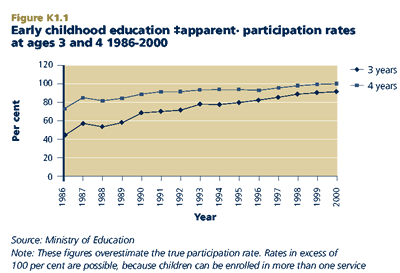
ETHNIC DIFFERENCES
Māori participation in early childhood education is relatively low compared to other ethnic groups but has increased over the last decade, particularly among three-year-olds. In 1991, the apparent participation rate of Māori was 50 per cent for three-year-olds and 65.1 per cent for four-year-olds. By 2000, these rates had risen to 58.9 per cent and 68.3 per cent of Māori three- and four-year-olds, respectively. In comparison, the apparent rates for non-Māori were over 100 per cent. While overall Māori apparent participation rates in early childhood education are relatively low compared to non-Māori, there are regional variances in this disparity with some areas showing high levels of Māori enrolment.
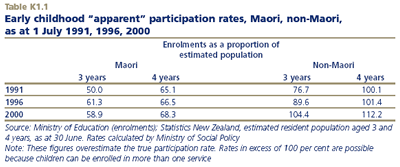
The most recent data for Pacific children shows that, in 1996, 66 per cent of three-yearolds and 80 per cent of four-year-olds were enrolled in early childhood programmes. This represents a rise since 1991, when 52 per cent of Pacific three-year-olds and 79 per cent of four-year-olds were enrolled.
A better measure of early childhood education participation data, which avoids the problem of double counting through children attending multiple programmes at the same time, comes from newly available information collected when children are in Year One at school. This shows that, as at July 2000, 86 per cent of all Year One students had attended some form of early childhood education service before starting school. There were marked ethnic differences with European/Pākehā Year One students being the most likely to have attended (92 per cent, compared with 79 per cent of Māori and 69 per cent of Pacific Year One students).
PARTICIPATION BY TYPE OF EARLY CHILDHOOD EDUCATION SERVICE
Kindergartens are still the most widely used form of early childhood education service for three- to four-year-olds, accounting for around 41 per cent of all enrolments. Childcare centres cater for another large group (35 per cent), with much smaller proportions in Playcentres (7 per cent) and kōhanga reo (6 per cent). Among children under three years attending early childhood education programmes, childcare services account for almost half of all enrolments (48 per cent), with playgroups (18 per cent) and playcentres (14 per cent) the next most widely used.
INTERNATIONAL COMPARISON
Compared with other countries, participation in early childhood education is high in New Zealand . New Zealand ranks sixth out of 28 OECD countries in the proportion of under five-year-olds enrolled in early childhood education programmes, behind Belgium, France, Iceland, Italy and Spain.
School leavers with higher qualifications
DEFINITION
Proportion of secondary school leavers who leave school with Sixth Form Certificate in at least one subject, or with a higher qualification.
RELEVANCE
Upper secondary education serves as the foundation for higher (postsecondary) learning and training opportunities as well as preparation for direct entry into the labour market. Those who leave school early with few qualifications are at much greater risk of unemployment or vulnerability in the labour force and of having low incomes.
CURRENT LEVEL AND TRENDS
In 1999, 66 per cent of school leavers left school with at least Sixth Form Certificate. This proportion has increased considerably from 47 per cent in 1986. Between 1991 and 1999, however, the proportion leaving school with at least Sixth Form Certificate remained relatively constant at between 63 per cent and 66 per cent. This may have been due to the increasing range of post-school training opportunities available through polytechnics and private training establishments. The upward trend in the late 1980s is also likely to have been caused partly by the declining number of job opportunities during that period. The proportion of school leavers attaining an A or B Bursary or Scholarship also increased during the period 1986 to 1991 and remained around 20-22 per cent over the 1990s.
GENDER DIFFERENCES
Among 1999 school leavers, females were more likely than males to leave school with Sixth Form Certificate or higher qualification (70 per cent compared with 62 per cent). Since 1986, the proportion of school leavers with at least Sixth Form Certificate has improved at a faster rate for females than for males.
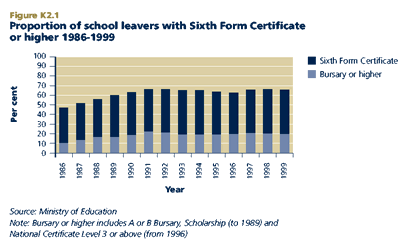
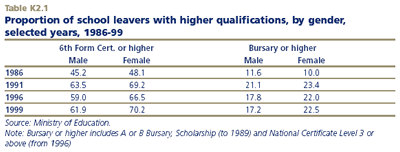
ETHNIC DIFFERENCES
In 1999, 43 per cent of Māori school leavers and 54 per cent of Pacific school leavers had Sixth Form Certificate or a higher qualification. This compares with 66 per cent of all school leavers. While the proportion of Māori leaving school with higher qualifications has been increasing faster than the average, Māori still lag considerably behind other groups in the qualifications they attain at school.
There is also a substantial difference between ethnic groups in the proportions leaving school with Bursary or similar higher qualifications. In 1999, 4.5 per cent of Māori and 4.2 per cent of Pacific school leavers gained an A or B Bursary or National Certificate at Level 3 or above. This compared with 19.8 per cent of all school leavers. These proportions did not change significantly between 1991 and 1999, except for some decrease in the proportion of Pacific students gaining these higher qualifications.
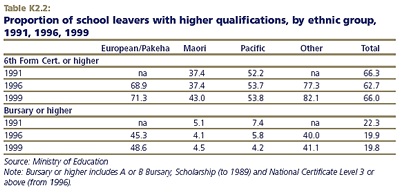
Educational attainment of the adult population
DEFINITION
The proportion of adults aged 25-64 years with educational attainment of at least upper secondary school level.
RELEVANCE
The educational attainment of the adult population is an important indicator of the skills available in the economy. The level of formal educational qualifications in the population is a commonly used proxy for the stock of "human capital", that is, the skills available in the population and labour force. Ideally such a measure would include the skills and competencies people gain through work and daily life but for which they have no formal qualification. Currently no such data exists.
CURRENT LEVEL AND TRENDS
In 2000, 71.1 per cent of the population aged 25-64 years had attained an educational qualification of upper secondary level or above. This proportion has steadily increased from 62.3 per cent in 1991. Over the same period the proportion of adults with a Bachelor's degree or higher qualification rose from 8.0 per cent to 12.6 per cent. While some of the increase is due to adults gaining additional qualifications, most of the upward trend is due to new entrants to the 25-64 age group (young people and migrants) being better qualified on average than people reaching retirement age.
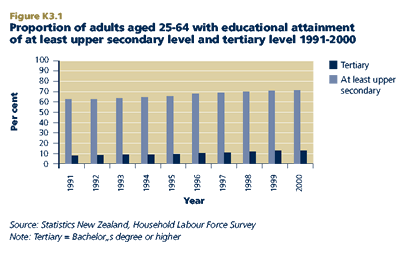
AGE AND GENDER DIFFERENCES
Younger adults aged 25-34 years are much more likely to have at least upper secondary school qualifications than adults aged 55-64 (77.8 per cent compared to 56.3 per cent). Similarly, young adults are more likely than older people to have tertiary qualifications (15.3 per cent compared to seven per cent).
Gender differences in educational attainment have narrowed over time. For the 25-34 year old age group, the proportions of men and women with higher qualifications are similar. In contrast, at older ages men are much more likely than women to have higher educational qualifications.
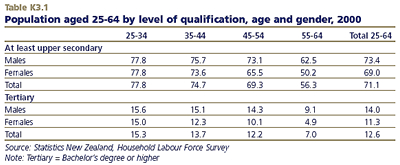
ETHNIC DIFFERENCES
Māori and Pacific adults are much less likely than European/Pākehā and other ethnic groups to have higher qualifications. As at June 2000, around half of Māori and Pacific adults aged 25-64 held upper secondary qualifications, compared to three-quarters of Europeans/Pākehā. Similarly, just four per cent of Māori and Pacific adults held a tertiary qualification at Bachelor's degree level or above, compared to almost 13 per cent of Europeans/Pākehā. Since 1991, however, growth in the proportion of adults with higher qualifications was fastest among Māori and Pacific adults.
The growth in the proportion of Pacific peoples with higher qualifications reflects the increasing proportion of the Pacific population who are born and educated in New Zealand . The relatively high percentage of the "Other" ethnic group with higher qualifications reflects the impact of the targeted migration system, which gives priority to people with tertiary qualifications related to their occupation.
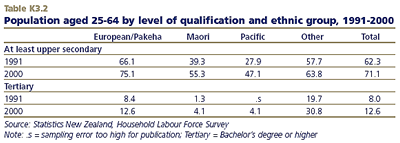
INTERNATIONAL COMPARISON
In 1998, New Zealand ranked 11th in a list of 28 OECD countries in the proportion of the population aged 25-64 years having at least an upper secondary educational qualification and 14th in the proportion who have completed tertiary qualifications to Bachelor's degree or higher.
Adult literacy skills in English
DEFINITION
The proportion of the population aged 16-65 with higher literacy skills in English (defined as prose, document and quantitative skills at Level 3 or above), as measured in the 1996 International Adult Literacy Survey (IALS).
RELEVANCE
The increasing complexity of our society and the need for a more flexible and highly educated workforce mean that individuals need to be able to comprehend and apply information of varying difficulty from a range of sources to function effectively at work and in everyday life. The International Adult Literacy Survey (IALS) was designed to measure adult literacy skills by assessing proficiency levels, using test materials derived from specific contexts within countries. IALS Level 3 is the level considered the minimum required for individuals to meet the complex demands of everyday life and work in the emerging knowledge society.
CURRENT LEVEL (NO TREND DATA AVAILABLE)
Results from the first international literacy survey in 1996 show that 54 per cent of New Zealand's population aged 16-65 had higher level prose literacy skills (Level 3 or above); 51 per cent had higher level document skills, and 50 per cent had higher level quantitative skills.
AGE DIFFERENCES
Across all three domains the proportion of people with higher level literacy skills was broadly similar for people aged 16-49 but then declined with age for people aged over 50. Poorer literacy levels among those aged over 50 may be due either to differences in the education received by older people or to a decline in these skills over time.
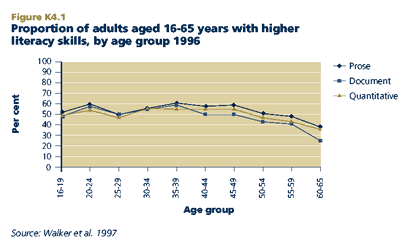
GENDER DIFFERENCES
Women performed better than men in prose literacy (58 per cent at Level 3 or above compared with 50 per cent for men). The reverse was true in respect of quantitative skills: 55 per cent of men had higher level quantitative literacy skills compared with 47 per cent of women. Differences between men and women in respect of higher level document literacy skills were negligible.
ETHNIC DIFFERENCES
Europeans/Pākehā consistently had the largest proportions with higher levels of literacy across all three domains, with a clear majority having skills at Level 3 or above. Pacific peoples consistently had the smallest proportions at this level (less than a third in each domain). Māori had a larger proportion than other non-European/Pākehā ethnic groups in the higher levels of prose literacy but a smaller proportion in the document and quantitative literacy domains.
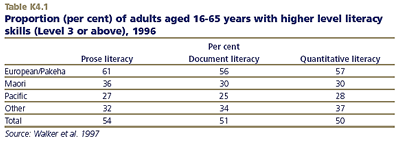
Among Māori and Pacific adults, there were considerable gender differences favouring males in the document and quantitative domains that were not evident among Europeans/Pākehā. For example, only 18 per cent of Pacific females were at the higher levels of quantitative literacy compared with 42 per cent of Pacific males. The gender disparity was not as great among Māori but was still substantial, with 26 per cent of females at the higher levels of quantitative literacy compared with 36 per cent of males.
INTERNATIONAL COMPARISON
Of the 13 countries surveyed so far, only two had average prose literacy scores significantly higher than New Zealand's. Five had significantly higher average document literacy scores and eight had significantly higher average quantitative literacy scores.
Participation in tertiary education
DEFINITION
The proportion of the population aged 16 and over studying for a New Zealand registered tertiary qualification. This includes universities, polytechnics, colleges of education, wānanga, private training establishments and industry training.
RELEVANCE
Participation in tertiary education provides individuals with skills and knowledge that allow them to participate in society and the economy.
CURRENT LEVEL AND TRENDS
In 2000, 9.1 per cent of the population over 16 years old was enrolled in tertiary education. Rates for those in the 16-24 age group were 28.3 per cent, compared with 5.4 per cent for those aged 25 and over. Participation in New Zealand tertiary education increased in the late 1980s and early 1990s, although growth is now slowing.
AGE AND GENDER DIFFERENCES
The overall increases in participation in tertiary education have resulted from increased participation in both the high incidence age group (those aged 16 to 24) and those aged over 25. Rates increased from 26.2 per cent in 1997 to 28.3 per cent in 2000 for the high incidence group. The rate of participation of people aged 25 and over increased from five per cent to 5.4 per cent over the same period.
Women are increasingly more likely than men to participate in tertiary study. The period 1997 to 2000 showed a larger increase in tertiary participation for women than for men.
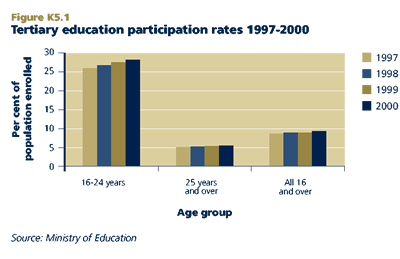

OTHER DIFFERENCES
Students from schools drawing from lower socio-economic communities are significantly less likely to go on to tertiary education than students from other schools. It is estimated that only 32 per cent of students leaving schools from low socio-economic communities in 1998 (deciles 1-3) were enrolled in tertiary education in 1999. This compared with 71 per cent of students leaving deciles 8-10 schools.
INTERNATIONAL COMPARISONS
New Zealand has high participation in tertiary education both in absolute terms and relative to other OECD countries. In 1995, New Zealand ranked eighth out of 22 OECD countries in its rate of participation in tertiary education for both women and men.
